

The Korg DSS-1, released
in
1986, is a monster hybrid of analog, digital, and sampling-based
synthesis. It has the best Voltage Controlled Filter (VCF) that Korg
ever bestowed on a synthesizer (it was also the last VCF-based synth
that Korg ever made). Even
today, a resonant filter sweep from the DSS-1
can put all but the mightiest
analog synths to shame! It's an eight-voice polysynth with two
oscillators
per voice, and a unison mode that allows you to stack up all 16
oscillators
into one very phatt and powerful monosynth.
But the DSS-1 is much more than just an analog subtractive synthesizer. It's also a sampler, and an additive synthesizer as well. All methods can be freely mixed within a single patch. This gives it a unique character all its own, with the ability to create very original sounds. When it was first released, its tiny 256k of sample memory and 720k floppy disk storage was considered the standard for affordable samplers of the day (such as the Ensoniq Mirage and Sequential Circuits Prophet 2000). This is a far cry from the capability and specs of today's modern samplers. But the DSS-1 really comes into its own, not as a dedicated sampler, but as an analog synthesizer that allows you to use any sample or waveform as raw material for its twin oscillators. It's a huge beast, weighing in at a hefty 40 pounds and measuring larger in size than a Korg Trident or a Roland JD-800 (and almost as big as an Oberheim Matrix 12!). While its control panel consists of only 27 buttons, 4 sliders, and a small, backlit LCD screen, the operating system is vast and quite flexible. Every control function or parameter is neatly silkscreened on the front panel, making it easy to find your way around. The LCD shows a clear indication of parameters and what they're doing.
At the heart of the DSS-1
is
a 12-bit sampler with fixed sampling rates of 16, 24, 32 and 48kHz.
Maximum
sampling times range from 16 seconds down to a crisp clean 5.5 seconds
at the quite impressive top rate of 48kHz. Sampling is actually a
pretty
straightforward process, with the menu system guiding you through
sample-rate
selection, number of sample divisions, the key number for samples, and
so on. There is an auto-loop facility which includes crossfade looping
and back-and-forth looping - which will get you some way towards
creating
a seamless loop. 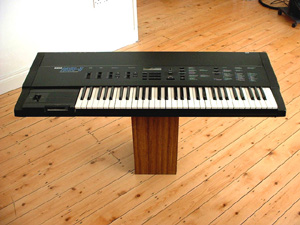 Raw
sample data can be edited from the instrument itself, although you'd
have
to be rather fanatical to make much use of this facility via the small
LCD. Instead, you can use a PC-based sample editor that supports the
MIDI
sample dump standard, and exchange samples to and from the DSS-1.
Raw
sample data can be edited from the instrument itself, although you'd
have
to be rather fanatical to make much use of this facility via the small
LCD. Instead, you can use a PC-based sample editor that supports the
MIDI
sample dump standard, and exchange samples to and from the DSS-1.
Aside from sampling, you
can
use two other methods for creating your own oscillator waveforms:
additive
harmonic synthesis, and drawing your own waveform with one of the data
sliders. With additive harmonic synthesis, the DSS-1 allows you to
create
your own custom timbres through the addition of 128 sine waves, giving
you the possibility of crisp DX7-like electric pianos, or glassy
'digital' pads with stunning transparency. You can also achieve some
rather
PPG-like tones, especially when the DSS-1's powerful filter is brought
into
play. The waveform-drawing feature allows you a specified amount of
time
to thrash about with one of the data sliders, resulting in a digital
waveform
of your own creation. Smooth, steady sweeps of the slider result in
soft,
"flutey" sine wave shapes, while quick, jerky movements of the slider
result
in hard, "buzzy" sawtooth or triangle wave shapes; or even hollow,
"reedy"
square or pulse-shaped waveforms. Very complex and unique waveforms can
be created by a mixture of slow and fast movements of the slider. 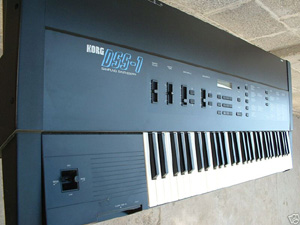 The
DSS-1 was the first affordable sampler/synthesizer to include a
facility
like this. Previously, you needed to buy a $50,000 Fairlight or
$100,000
Synclavier to get your hands on this kind of digital waveshaping
functionality.
Of course, it's not nearly as advanced as drawing your waveform on a
stylus-sensitive sketch pad or a light-pen sensitive monitor, but it's
there - and it works.
The
DSS-1 was the first affordable sampler/synthesizer to include a
facility
like this. Previously, you needed to buy a $50,000 Fairlight or
$100,000
Synclavier to get your hands on this kind of digital waveshaping
functionality.
Of course, it's not nearly as advanced as drawing your waveform on a
stylus-sensitive sketch pad or a light-pen sensitive monitor, but it's
there - and it works.
In many ways, the DSS-1
can
be seen as a kind of transitional synthesizer bridging the gap between
the analog/digital
hybrids of the early-to-mid 80s and the "rompler" based synths of the
late
80s and beyond. When first released in 1986,
advertisements and trade papers were touting the DSS-1 for its sampling
aspect. At the time, the world had grown tired of analog synthesis -
with
such digital keyboards as the Yamaha DX7 and Ensoniq Mirage at pole
position.
Rather ironic in this context is the fact that the Korg DSS-1 contained
an extremely powerful
and versatile analog synthesis engine, capable of producing very phatt
brass
and string pads, as well as lush, resonant filter
sweeps popular in today's dance-oriented genres. What the DSS-1 does
not offer on its front panel are a plethora
of dedicated knobs and sliders for immediate hands-on control of all
its parameters. Instead, it replaces this more expensive hardware
outlay with a series of buttons, two data sliders, and an LCD screen.
This
was typical of nearly all synthesizers of that time period, whether an
analog/digital hybrid, or a fully digital synthesizer. While this is
mostly
seen as a negative in today's analog revival world, real-time control
of
such features as filter resonance or LFO frequency is possible by
assigning the
desired parameter to one of the data sliders. So, mainly for this
reason,
the DSS-1 often gets a bad rap by today's analog enthusiasts. But,
surprisingly,
inside this beast is pure analog power that other synthesizers,
including
many "legendary" fully analog synths, could only dream of.
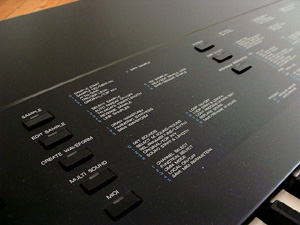
The DSS-1 is no "analog modelling" synth - it's the real deal. It has a fully analog audio path including a lush, resonant VCF switchable between 12 and 24dB, dedicated 6-stage envelopes for both the VCF and VCA, and 2 sine wave LFOs (which Korg calls "MG", for Modulation Generator). But it went much further, boasting oscillator sync, an advanced unison mode, and - quite unique for a synth of the time - twin digital delays! The addition of oscillator sync, so unusual on a sampling instrument, opens the door to vibrant timbres plus the strangest of textural sweeps. The unison mode allows you to detune all 16 oscillators against each other (instead of just 8 against the other 8 as on the earlier DW-8000) for some very phatt lead or bass sounds. But what gives the DSS-1 its very distinctive sound - apart from its wonderful filter, of course - are the built-in twin digital delays, each of which is connected to a separate output for interesting stereo effects. Additionally, the rate of Delay1 can modulate the rate of Delay2 for some rich, swooshy stereo chorus effects that belie the simplicity of the available parameters. While the DSS-1 lacks pulse width modulation (PWM), which is often used to create very lush string sounds, some of the factory disks contain an interesting PWM sampled loop, which helps to compensate for this omission. Another interesting technique to get PWM-like sounds is by sync-sweeping a square wave. So the DSS-1 can create very phatt and powerful analog strings comparable to a Jupiter 8 or a Matrix 12!
The DSS-1 has one of the
most
responsive velocity and aftertouch sensitive keyboards on any
synthesizer. Particularly expressive is the aftertouch, which is far
more responsive and dynamic than just about any synth out there
(including most of Korg's other synths from any time period!).
Aftertouch can be applied to almost any
parameter including filter cutoff, LFO intensity, or autobend (another
unique
feature which bends the note up or down to its true pitch over a
specified
period of time). The
main performance controller is Korg's familiar joystick, in which
the normal pitch bending for left/right movements can be turned off,
and
instead used to modify the filter cutoff or LFO intensity (giving you a
second
performance controller when used in conjunction with the data slider).
Up/down movements of the joystick control the oscillator modulation and
filter modulation, respectively. 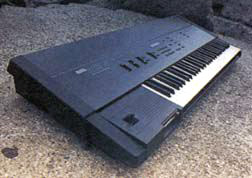 There
are two separately programmable LFO's, one for the oscillator pitch and
one for the filter cutoff, but the only waveform available is a sine
wave, and the LFOs are unfortunately always sync'ed to keyboard
triggering. However, a technique to get a free-flowing LFO involves
holding down a note outside the defined multisample key range, and
voilà - those evolving filter-swept bass lines are suddenly
possible!
There
are two separately programmable LFO's, one for the oscillator pitch and
one for the filter cutoff, but the only waveform available is a sine
wave, and the LFOs are unfortunately always sync'ed to keyboard
triggering. However, a technique to get a free-flowing LFO involves
holding down a note outside the defined multisample key range, and
voilà - those evolving filter-swept bass lines are suddenly
possible!
While undoubtedly a very powerful synthesizer, the sampling memory inside the DSS-1 leaves a lot to be desired (when compared to modern samplers). But the thing to remember about the DSS-1 is to see it as a very powerful analog polysynth that lets you use any sound source for its warm and powerful analog synth engine. It has 384k of internal memory, and only 256k of this is used for multisamples. The remainder is used for patch data, MIDI parameters, and so on. You must insert a 3½" floppy disk and load a complete System into memory each time you power up the DSS-1, which is perhaps one of its less endowed aspects (it takes up to 30 seconds to load a complete System into memory, depending on the number and size of multisamples to be loaded). Each disk contains four Systems (a System is a bank of 32 patches plus up to 16 multisamples). These are labelled Systems A thru D. All four systems can share the same multisamples stored on a single disk (which will hold up to 525k worth of samples and multisamples). The DSS-1 uses the older 720k DSDD disks also used on the Mirage and on early Macintosh computers. These can be a bit difficult to find these days, but are still available from various computer warehouse distribution companies.
The DSS-1 has a very
complete MIDI spec, allowing for local off, separate channels for send
and receive, sysex support for patch bank dumps, realtime control of
all system parameters, and MIDI dump standard for importing and
exporting PCM sample data. However, there appears to be very little
third party software support for the DSS-1. 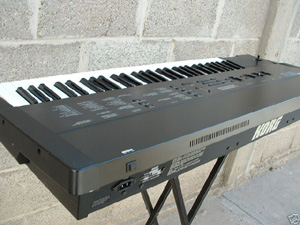 One of the
only known software programs that you can use with the DSS-1 is Turtle
Beach's
SampleVision - a graphical editor for Windows
which allows you to edit a DSS-1
sample on a PC, save it as a WAV file, and then return it to the
sampler
section of the DSS-1. This makes sample editing a breeze! You can also
use SampleVision to load completely new, professionally-sampled sounds
into the DSS-1,
thereby bypassing its comparatively noisy 12-bit DAC converter. This
software
is no longer produced or supported, but you can obtain a free copy here. There's also MIDIQuest,
which works with about 500 other synths and samplers too, and will cost
you $200 - roughly the same price as a used DSS-1. But you can download
a slightly "crippled" demo version here. This
software supports sysex control of DSS-1 patch bank dumps and all
system parameters. The same company also makes UniQuest, which is the same software but only
supports one synth, for half the price.
One of the
only known software programs that you can use with the DSS-1 is Turtle
Beach's
SampleVision - a graphical editor for Windows
which allows you to edit a DSS-1
sample on a PC, save it as a WAV file, and then return it to the
sampler
section of the DSS-1. This makes sample editing a breeze! You can also
use SampleVision to load completely new, professionally-sampled sounds
into the DSS-1,
thereby bypassing its comparatively noisy 12-bit DAC converter. This
software
is no longer produced or supported, but you can obtain a free copy here. There's also MIDIQuest,
which works with about 500 other synths and samplers too, and will cost
you $200 - roughly the same price as a used DSS-1. But you can download
a slightly "crippled" demo version here. This
software supports sysex control of DSS-1 patch bank dumps and all
system parameters. The same company also makes UniQuest, which is the same software but only
supports one synth, for half the price.
So what more can I say
about
this wonderful sampler/synthesizer that hasn't already been said?
Plenty.
I can talk a little more about the actual sound of the beast, rather
than
just its technical specs. The DSS-1 is a very underappreciated and
underrated
monster of analog synthesis. This means that it is going for very
little
money on eBay compared to synthesizers of similar or lesser
sonic capability. You
can get very phatt and punchy analog synth brass comparable to a
Prophet
5, and very lush Jupiter-8 like strings that will make you weep. In
unison mode, you can
create extremely punchy basses and lead synth lines that growl at the
low
end and scream at the high end. Aside from all of these wonderful
analog
sounds, the DSS-1 is quite capable of creating clean, glassy, evolving
"digital" sounds typical of what you might find on a Roland D50 or Korg
M1. The more complex looped samples allow for this - something you
can't
achieve using basic waveforms alone. 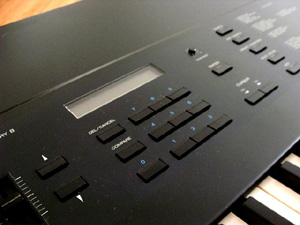 Finally,
extremely weird sound effects can be achieved because of the additive
synthesis
facility, so you can get those gnashy, aggressive modulated tones found
on an FM synthesizer like the Yamaha DX7. There's a lot going on inside
this beast, and that's the reason why it's so huge and heavy: it took a
lot of circuitry in 1986 to combine all of these synthesizer facilities
in one unit!
Finally,
extremely weird sound effects can be achieved because of the additive
synthesis
facility, so you can get those gnashy, aggressive modulated tones found
on an FM synthesizer like the Yamaha DX7. There's a lot going on inside
this beast, and that's the reason why it's so huge and heavy: it took a
lot of circuitry in 1986 to combine all of these synthesizer facilities
in one unit!
The DSS-1 lacks portamento, which is a rather unfortunate omission. But since it is a creature of its time, form often follows fashion. So features that a Keith Emerson or Rick Wakeman would use were often omitted in favor of those features a Depeche Mode or Tears For Fears would prefer. Also notable are the omission of a built-in arpeggiator and sequencer. Again, a built-in arpeggiator would have been a nice addition, but in today's world of inexpensive, fully-featured PC based sequencers, you probably won't find the omission of a sequencer all that disturbing. The DSS-1 is also a monotimbral instrument in that you can't map different internal sounds to different MIDI channels (but you can map as many as 30 internal samples across the keyboard). This is a synth, not a workstation - it was aimed at professional keyboardists - and the omission of an arpeggiator and sequencer means that it's more suited to being played, as opposed to being used as a multitrack recording facility. But you can always MIDI it up to a hardware or software-based sequencer for greater expandability.
So there you have it, a monster of a synth that originally sold for $2,700 but goes for around $320 these days! Sooner or later it is bound to become a sought-after classic once people realize just how powerful it is. It is definitely one of the best kept secrets on the second-hand synth market right now!
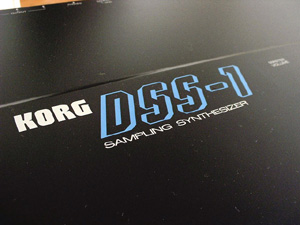
There is a rack mount version called the DSM1. However, it sacrificed some of the more powerful analog synthesis features of the DSS1 in favor of more advanced sampling capabilities: it omitted the digital delays, twin oscillator patches, oscillator sync, and (worst sin of all) the resonance that gave the DSS1 much of its character. In place of these, the DSM1 had four times as much memory (1 mb), a much faster operating system, a high density disk drive, individual outputs, and a multitimbral mode.
Competitors to the Korg DSS1 include the Ensoniq Mirage and EPS, Akai X7000 and S900, Sequential Circuits Prophet 2000, Emu Emax, Casio FZ1, and Roland S50.
It has been used professionally by Michael Cretu of Enigma, Jean-Michel Jarre, Mark Jenkins, Hiro Kawahara, Paul Nagle, Roger Powell of Utopia, Shriekback, Steve Winwood, and Joe Zawinul.
Although the DSS-1 is a
pretty
reliable and well-built synth, be aware (if you are considering buying
one second-hand) that often the first thing to fail on a used DSS-1 is
the
disk drive. It depends on how frequently it was used during its
lifetime.
Be careful when bidding on eBay to read all of the fine print in the
seller's
comments. If it says there is disk drive failure, this brings the worth
of the used synth down quite a bit, to maybe between $40 and $80, no
more.
The reason is that a new disk drive will cost you about $70 including
shipping,
and also your time and labor to install it. You will not get very far
on
a DSS-1 without a working disk drive. Most used DSS-1's seem to still
have
an original working disk drive, or one that was replaced somewhere
along
the way of its ownership chain. You can purchase new floppy drives for
the DSS-1 here. Please note that not just any
floppy disk drive will
work with the DSS-1. It must be a particular brand and model type, with
the jumpers set to a particular configuaration. If you really know
your floppy drive and hardware configuratons, you may be able to find a
compatible used drive sitting around somewhere in a computer scrap heap.
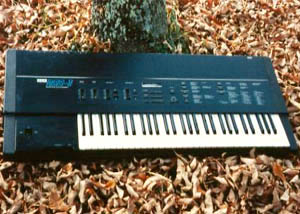
Often sellers will not include very many floppy disks (containing your vital samples and patches), if any at all. You will not get very far without at least a modest set of DSS-1 factory-made or custom-made floppies. If you need to get started, or build up your existing library of disks, go no further than here. Be sure to read the section telling you how to install and run the CopyQM software that will help you transfer the disk image files to 720k floppies. Also, we will point you to a section of the Route 66 Studios web site where you can still purchase the older style DSDD disks compatible with the DSS-1.
There was a legendary hardware upgrade made by SoundLogic (no longer available and extremely hard to find, as most of them have already been installed into existing DSS-1's). This upgrade replaced the existing Intel 8088 based chipset with a much faster DEC based one, increases the sampling memory from 256k to 2mb, replaces the DSDD floppy drive with a faster and higher capacity DSHD drive, and - most importantly - installs a SCSI port on the DSS-1 allowing you to connect it to an external hard drive for much faster and significantly increased storage. These kits have been all bought up and installed into existing DSS-1's. However, there is a new upgrade kit available as of October 2009 that is greatly improved over the old upgrade kit. Click here to learn more about it.
Be sure to
check out all of the DSS-1 Resources on this site by clicking on the
links in the menu at the top of the page. These links guide you to
pages dedicated to providing DSS-1 users with the resources they need
to enjoy this wonderful instrument. You will find a large cache of
DSS-1 disk images for free download. We have also made available the
only surviving DSS-1 visual editor for the PC. Yes, you heard right!
And, you will learn how to use it to load WAV files into your DSS-1.
Without
question,
the most frequent thing users of the DSS-1 want to do here is convert
the
DSS-1 image files to floppies that the DSS-1 can use. Please check out
the CopyQM and Omniflop
sections carefully. They will guide you through the process.